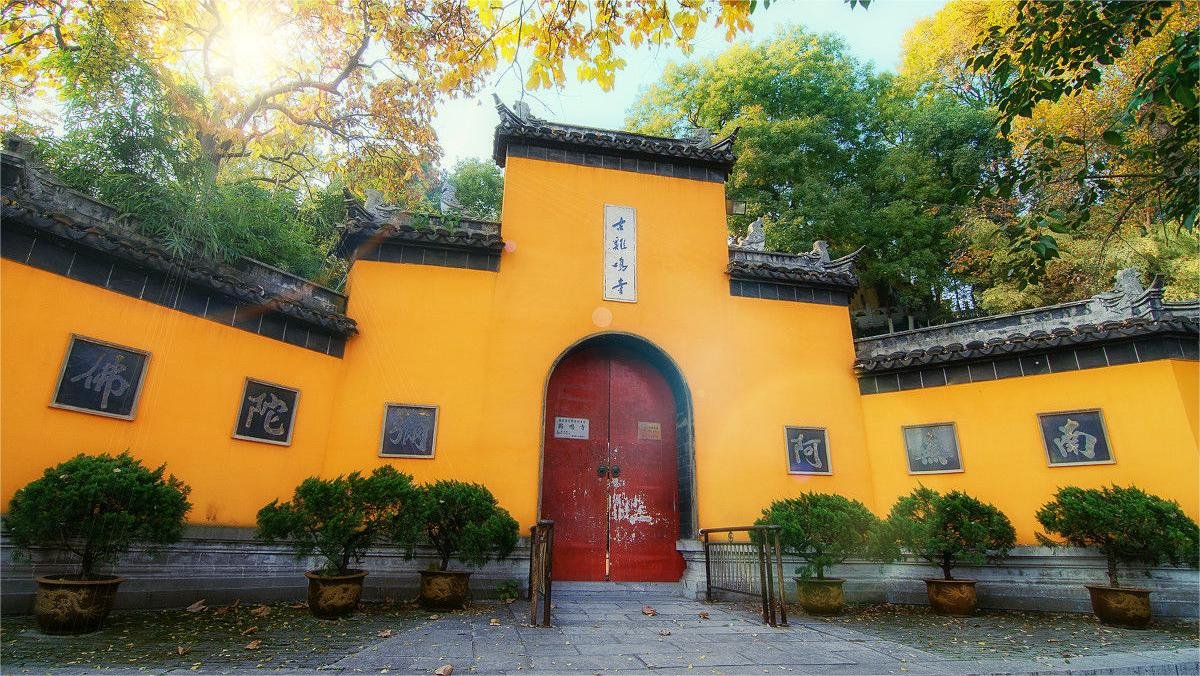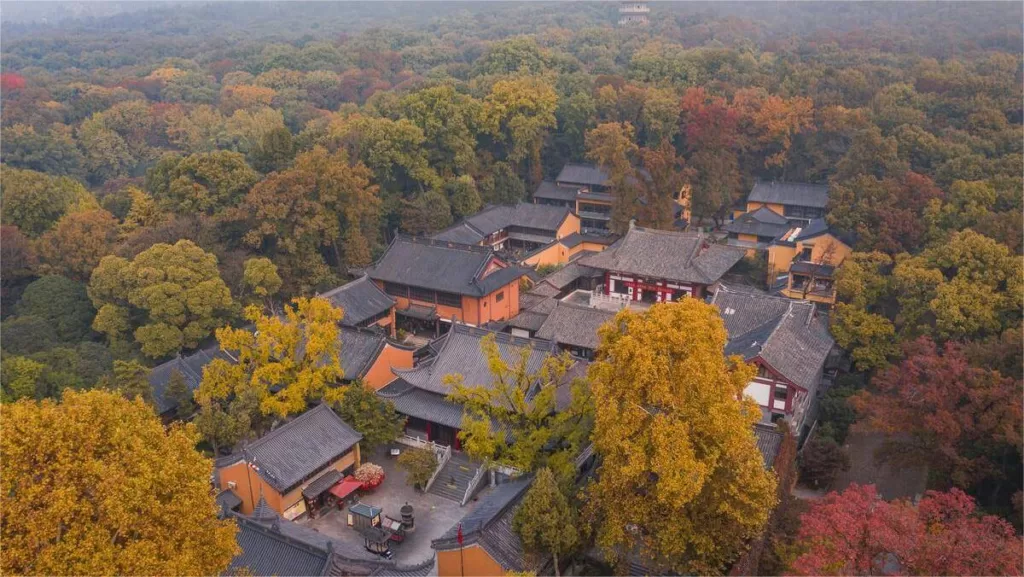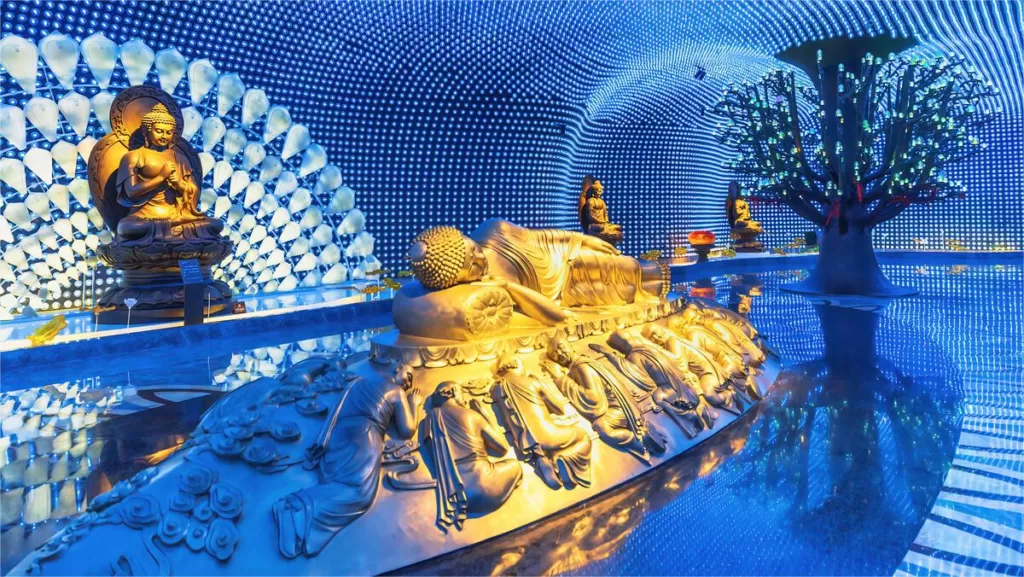Jiming Temple (鸡鸣寺), known as the Rooster’s Crow Temple in English, is a place of profound historical and cultural significance located in Nanjing, China. With a history dating back over 1,700 years, it stands as one of the oldest Buddhist temples in the city and a testament to the enduring spirit of faith.
Jiming Temple traces its roots to the Eastern Wu dynasty, established on land that was once part of the Wu kingdom’s royal gardens during the Three Kingdoms era. The temple’s history begins in the year 300 AD during the Western Jin dynasty when a hermitage was built on this site. After the Eastern Jin dynasty, it was used for various governmental purposes, and it wasn’t until 527 AD during the Southern Liang dynasty when Emperor Wu built the Tongtai Temple. This temple played a crucial role in the propagation of Buddhism in China. During the Southern Tang dynasty, it was renamed as Jingju Temple, and later during the Song dynasty, it became known as Fabao Temple.
In the 14th century, during the Ming dynasty, Emperor Zhu Yuanzhang ordered the reconstruction of the temple, significantly expanding its scale and gave it the name “Jiming Temple.” Over time, the temple’s complex grew extensively, covering an area of more than a thousand mu (Chinese acres) with over thirty halls, pavilions, and buildings.
However, the temple faced destruction during the Qing dynasty, during the Xianfeng era, due to the ravages of war. It was later rebuilt during the Tongzhi era. In 1958, the temple was repurposed as a place for Buddhist nuns. In 1983, the temple was gradually restored and opened to the public.
Table of Contents
- Basic Information
- Location and Transportation
- Highlights of Jiming Temple
- Vlog about Jiming Temple
- Useful Tips Summarized from Reviews
- Attractions Near Jiming Temple
- Other Temples in Nanjing
Basic Information
| Estimated Length of Tour | 2 hours |
| Ticket Price | 10 RMB 20 RMB during the Spring Festival |
| Opening Hours | 7.30 – 17.00 throughout the year |
| Telephone Number | 0086-025-83361123 0086-025-57715595 |
Location and Transportation
Jiming Temple is located in Nanjing, a city in Jiangsu Province, China. The exact address of Jiming Temple is No. 1 Jimingsi Road, Xuanwu District. Situated on the southern side of Xuanwu Lake, the temple enjoys a picturesque setting surrounded by lush greenery and serene waters. To get there, you can choose the following ways:
Bus: Take bus 11, 20, or 48, get off at Beijing East Road Jiming Temple Stop (北京东路·鸡鸣寺站), and walk about 100 meters to the north to reach the temple.
Metro: The nearest metro station to the temple is Jiming Temple (鸡鸣寺站) on line 3 and line 4. After getting out of the station from Exit 5, walk about 150 meters to the north to reach the temple.
Highlights of Jiming Temple

Architectural Layout

Jiming Temple’s architectural layout is a testament to its rich history and cultural significance. The entrance to the temple is on the left side of Jiming Temple Road, with a stone staircase leading to the mountain gate. The mountain gate features the golden characters “古鸡鸣寺” (Ancient Jiming Temple). Upon entering, to the left, you’ll find the charity platform, known as “志公台.” In front of the charity platform is the Maitreya Hall. Above it stands the Grand Buddha Hall and the Guanyin Pavilion, housing gilded bronze statues of Shakyamuni Buddha and Guanyin Bodhisattva, which were gifted by Thailand. The temple has also recently added thirty-two new statues of Guanyin, enhancing the temple’s spiritual ambiance.
To the east of the Grand Buddha Hall is the remains of the Pingxu Pavilion, while to the west is the Pagoda Courtyard. The entire courtyard is paved with polished green stone, and the Medicine Buddha Pagoda, rebuilt in 1990, stands in the center. On the left of the Guanyin Pavilion, you’ll find the Huomeng Pavilion, a spacious and elegant structure.
The Incense Altar

The Incense Altar at Jiming Temple is a vibrant and spiritual hub, located on the southern platform. Here, you’ll find large red candles and lotus-shaped oil lamps, where visitors can light incense. The platform’s inner section holds incense sticks, which emit fragrant smoke, creating a sacred and serene atmosphere. The accumulated incense ash is periodically cleared by the temple’s monks through a lower-level passage.
Visitors from all directions gather at the Incense Altar, each facing their chosen direction when offering their prayers and incense. This diverse practice reflects the inclusive and welcoming nature of the temple.
Legend of Jiming Temple

Legend has it that on the Nine Hua Mountain near Xuanwu Lake in Nanjing, a fierce centipede spirit terrorized the area, posing a significant threat to both humans and livestock. The Jade Emperor in heaven learned of this menace and sent a celestial golden rooster to confront the centipede. The golden rooster, following the divine order, perched atop a temple on the mountain. With a resounding crow, the centipede spirit was so frightened by the deafening sound that it fled, and its venomous flames were extinguished. In honor of the golden rooster’s heroic act of protecting the people, the temple on the mountain was named “Jiming Temple,” which translates to the Rooster’s Crow Temple.
Medicine Master Pagoda

A significant addition to Jiming Temple is the Medicine Buddha Pagoda, constructed in 1991. This seven-story, eight-sided pagoda stands approximately 44.8 meters tall and features elaborate architectural elements such as dougong brackets and copper spires with tiled roofs. The pagoda is dedicated to the Medicine Buddha, representing health and longevity, and serves as a place for worshippers and visitors to offer prayers for safety and well-being.
Inside the pagoda, a bronze statue of the Medicine Buddha, originally from Beijing’s Yonghe Temple, is enshrined. The statue was gifted to Jiming Temple in 1972, a testament to the temple’s historical and spiritual significance.
Xuanwu Lake Views

Nestled near the enchanting Xuanwu Lake, Jiming Temple offers captivating views that enhance the overall experience for visitors. The temple’s proximity to the lake provides a serene backdrop of glistening waters and lush greenery. As one explores the temple grounds, they can enjoy scenic vistas of Xuanwu Lake, offering a tranquil respite from the bustling city. The elevated pagoda within Jiming Temple allows visitors to take in panoramic views of the surrounding area, including the lake, the temple complex, and the cityscape of Nanjing. These picturesque views create a harmonious blend of natural beauty and spiritual serenity, making the temple visit truly memorable.
Vlog about Jiming Temple
Useful Tips Summarized from Reviews
Vegetarian Hall at the Top: At the top of Jiming Temple, there is a Vegetarian Hall where you can try vegetarian noodles. There is a terrace from where you can see Xuanwu Lake and the city wall. The average cost per person is approximately 30-40 yuan.
Entrance and Exit in the Main Hall: When entering the main hall, make sure to enter from the left and exit from the right.
Two Entrances to Jiming Temple: Jiming Temple has two entrances. The archway entrance uses electronic tickets, and the old mountain gate uses paper tickets. Both can be purchased on-site without waiting in line.
Timing for Worshiping: If you plan to offer incense for blessings, it is essential to go in the morning, preferably as early as possible. If you are visiting just for sightseeing and enjoyment, it is recommended to go in the afternoon to avoid the morning crowd.
Exit Leads to Ming City Wall: The exit of Jiming Temple leads to the Ming City Wall. Following the city wall allows you to enjoy panoramic views of Xuanwu Lake and Jiming Temple.









Jiming Temple has no queue, but it was quite crowded inside. The popular photo spots are difficult to capture perfectly due to the number of people. They offer vegetarian meals in the temple, which is a plus.
The cherry blossoms at Jiming Temple have mostly fallen, but there are still lots of people!
Avoid driving or taking a taxi; it’s too congested! I recommend biking or walking instead!
Even though the cherry blossoms have fallen, the large area of purple bellflowers at the entrance is just gorgeous!
I left home a bit late and arrived at Jiming Temple around noon. The entrance fee is 10 RMB. The temple isn’t very large, so I was able to walk around quickly. Most of the flowers weren’t bloomed yet, but I can imagine they’ll look beautiful by the end of the month. I also encountered two big fat cats that live at the temple.
I went to the attraction just as it opened on New Year’s Eve. There weren’t many people at that time, but by 9 AM, security was tightened. It’s very convenient to book tickets online. Offering prayers has already become a staple activity for the New Year.